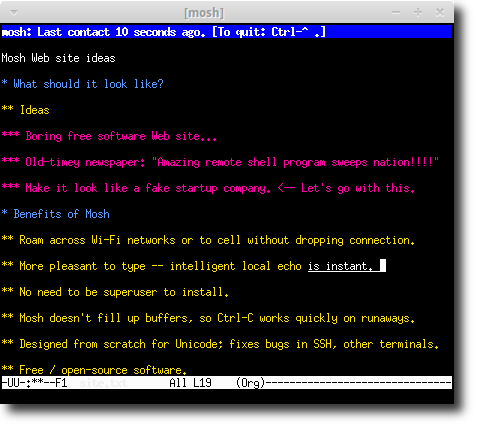131 private links
Mobile shell that supports roaming and intelligent local echo. Like SSH secure shell, but allows mobility and more responsive and robust.

LAN Share is a cross platform local area network file transfer application, built using Qt GUI framework. It can be used to transfer a whole folder, one or more files, large or small immediatelly without any additional configuration.
There are plenty of file sharing utilities on the web. Some of them are CLI-based, and some of them are GUI-based. Some of them are free, and some of them are paid. When it comes to share or transfer large files from command line over Internet, there are only a few.
One of them is Transfer.sh. No, it isn’t a script, it is a website. It allows you to share files over Internet easily and quickly. You don’t need to install anything except cURL or wget. Most of the Linux distributions comes preinstalled with those utilities, so you don’t need to install anything, really.
In this guide, we will discuss how to use the netcat utility. Often referred to as a Swiss army knife of networking tools, this versatile command can assist you in monitoring, testing, and sending data across network connections.
Network protocol design and evaluation requires either full implementation of the considered protocol and evaluation in a real network, or a simulation based on a model. There is also a middle approach in which both simulation and emulation are used to evaluate a protocol. In this article the Partov engine, which provides both simulation and emulation capabilities simultaneously, is presented. Partov benefits from a layered and platform-independent architecture. As a pure simulator, it provides an extensible plugin-based platform that can be configured to perform both real-time and non-real-time discrete-event simulations. It also acts as an emulator, making interaction with real networks possible in real time. Additionally, a declarative XML-based language is used, acting as a glue between simulation and emulation modules and plugins. It supports dynamic network modelling and simulation based on continuous time Markov chains. Partov is compared with other well-known tools such as NS-3 and real processes such as Hping3. It is shown that Partov requires less overhead and is much more scalable than NS-3.
In this paper we address a seemingly simple question: Is there a universal packet scheduling algorithm? More precisely, we analyze (both theoretically and empirically) whether there is a single packet scheduling algorithm that, at a network-wide level, can match the results of any given scheduling algorithm. We find that in general the answer is “no”. However, we show theoretically that the classical Least Slack Time First (LSTF) scheduling algorithm comes closest to being universal and demonstrate empirically that LSTF can closely, though not perfectly, replay a wide range of scheduling algorithms in realistic network settings. We then evaluate whether LSTF can be used in practice to meet various network-wide objectives by looking at three popular performance metrics (mean FCT, tail packet delays, and fairness); we find that LSTF performs comparable to the state-of-the-art for each of them.
Today do-it-yourself kit maker Spark.io is poking a hole into the Internet of things’ web of hidden communications between devices - by adding an actual button.
Seafile, lets you store your files and data on a central server and synchronize them with PCs and mobile devices. Seafile synchronizes your data between the Seafile server and the Seafile client applications installed on your laptops, desktops, smartphones, and tablets.
Seafile server is available for Windows and Linux operating systems and the Seafile client application is available for Windows, Mac, Linux, Android, and iOS. In addition to using Seafile clients, you can also use the web interface to access your files and data stored in Seafile server.
Seafile lets you create libraries where you can upload and organize your files. You can sync each library separately. While synchronizing your files, Seafile handles file conflicts, and transfers the data which is not already available in the server preventing unnecessary bandwidth usage. Using Seafile, you can sync your files with two or more servers and the file transfers can be resumed. Also, Seafile comes with full version control mechanism.
Mobile shell that supports roaming and intelligent local echo. Like SSH secure shell, but allows mobility and more responsive and robust.
(Web Offer One File) sets up an HTTP webserver to serve files from a given local directory; all the users connected to the network can see and download the files.
